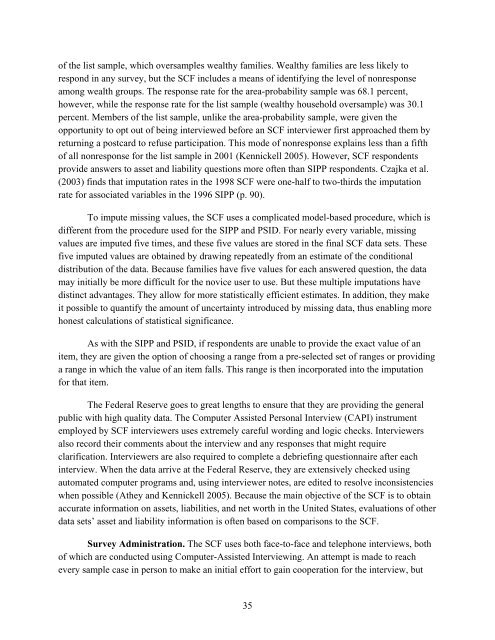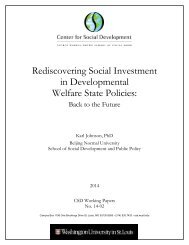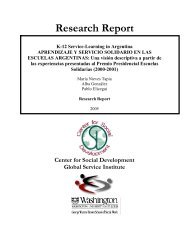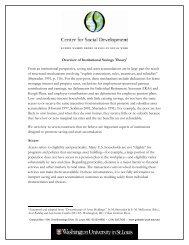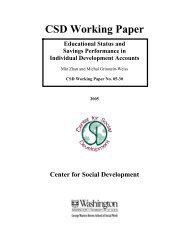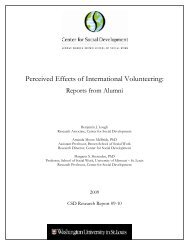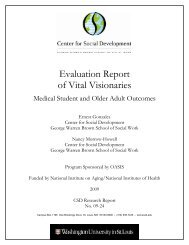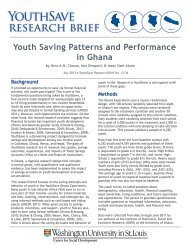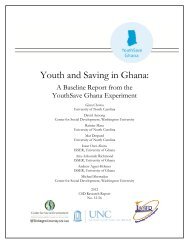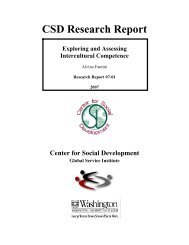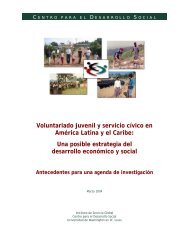Assessing Asset Data on Low-Income Households - Urban Institute
Assessing Asset Data on Low-Income Households - Urban Institute
Assessing Asset Data on Low-Income Households - Urban Institute
You also want an ePaper? Increase the reach of your titles
YUMPU automatically turns print PDFs into web optimized ePapers that Google loves.
of the list sample, which oversamples wealthy families. Wealthy families are less likely to<br />
resp<strong>on</strong>d in any survey, but the SCF includes a means of identifying the level of n<strong>on</strong>resp<strong>on</strong>se<br />
am<strong>on</strong>g wealth groups. The resp<strong>on</strong>se rate for the area-probability sample was 68.1 percent,<br />
however, while the resp<strong>on</strong>se rate for the list sample (wealthy household oversample) was 30.1<br />
percent. Members of the list sample, unlike the area-probability sample, were given the<br />
opportunity to opt out of being interviewed before an SCF interviewer first approached them by<br />
returning a postcard to refuse participati<strong>on</strong>. This mode of n<strong>on</strong>resp<strong>on</strong>se explains less than a fifth<br />
of all n<strong>on</strong>resp<strong>on</strong>se for the list sample in 2001 (Kennickell 2005). However, SCF resp<strong>on</strong>dents<br />
provide answers to asset and liability questi<strong>on</strong>s more often than SIPP resp<strong>on</strong>dents. Czajka et al.<br />
(2003) finds that imputati<strong>on</strong> rates in the 1998 SCF were <strong>on</strong>e-half to two-thirds the imputati<strong>on</strong><br />
rate for associated variables in the 1996 SIPP (p. 90).<br />
To impute missing values, the SCF uses a complicated model-based procedure, which is<br />
different from the procedure used for the SIPP and PSID. For nearly every variable, missing<br />
values are imputed five times, and these five values are stored in the final SCF data sets. These<br />
five imputed values are obtained by drawing repeatedly from an estimate of the c<strong>on</strong>diti<strong>on</strong>al<br />
distributi<strong>on</strong> of the data. Because families have five values for each answered questi<strong>on</strong>, the data<br />
may initially be more difficult for the novice user to use. But these multiple imputati<strong>on</strong>s have<br />
distinct advantages. They allow for more statistically efficient estimates. In additi<strong>on</strong>, they make<br />
it possible to quantify the amount of uncertainty introduced by missing data, thus enabling more<br />
h<strong>on</strong>est calculati<strong>on</strong>s of statistical significance.<br />
As with the SIPP and PSID, if resp<strong>on</strong>dents are unable to provide the exact value of an<br />
item, they are given the opti<strong>on</strong> of choosing a range from a pre-selected set of ranges or providing<br />
a range in which the value of an item falls. This range is then incorporated into the imputati<strong>on</strong><br />
for that item.<br />
The Federal Reserve goes to great lengths to ensure that they are providing the general<br />
public with high quality data. The Computer Assisted Pers<strong>on</strong>al Interview (CAPI) instrument<br />
employed by SCF interviewers uses extremely careful wording and logic checks. Interviewers<br />
also record their comments about the interview and any resp<strong>on</strong>ses that might require<br />
clarificati<strong>on</strong>. Interviewers are also required to complete a debriefing questi<strong>on</strong>naire after each<br />
interview. When the data arrive at the Federal Reserve, they are extensively checked using<br />
automated computer programs and, using interviewer notes, are edited to resolve inc<strong>on</strong>sistencies<br />
when possible (Athey and Kennickell 2005). Because the main objective of the SCF is to obtain<br />
accurate informati<strong>on</strong> <strong>on</strong> assets, liabilities, and net worth in the United States, evaluati<strong>on</strong>s of other<br />
data sets’ asset and liability informati<strong>on</strong> is often based <strong>on</strong> comparis<strong>on</strong>s to the SCF.<br />
Survey Administrati<strong>on</strong>. The SCF uses both face-to-face and teleph<strong>on</strong>e interviews, both<br />
of which are c<strong>on</strong>ducted using Computer-Assisted Interviewing. An attempt is made to reach<br />
every sample case in pers<strong>on</strong> to make an initial effort to gain cooperati<strong>on</strong> for the interview, but<br />
35


